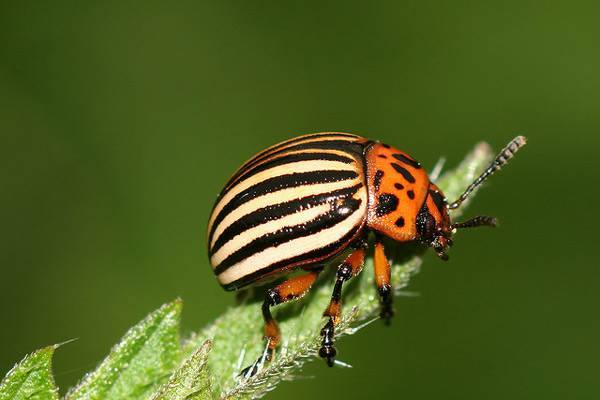 Potato is one of the main foodstuffs on the table for residents, both cities and villages of Russia, Belarus, Ukraine. But this, the most popular vegetable crop has a lot of enemies and diseases that can minimize all the efforts of a person.
Potato is one of the main foodstuffs on the table for residents, both cities and villages of Russia, Belarus, Ukraine. But this, the most popular vegetable crop has a lot of enemies and diseases that can minimize all the efforts of a person.
There is always someone to deal with these scourges; there are various methods of treatment and opportunities to save crops.
Content
Potato Pests
Colorado beetle
The main scourge of potato plantations. The basis of beetle food is potatoes, from leaves to tubers. It feeds on other species of nightshade. Chemical means for killing an insect: insecticides "Masterpiece", "Prestige", "Batsikol" or "Dendrobacilin". Folk remedies: manual collection of eggs, pest larvae and adult beetles, spraying of crops with various infusions and decoctions of celandine, wormwood, horsetail or dandelion, a solution of wood ash. Aisles are mulched with a mixture of sawdust birch and spruce. One popular way: 1 kg of dry mustard is diluted in 10 liters of water, 100 ml of 9% table vinegar is added, then everything is mixed. The solution irrigate the tops of potatoes.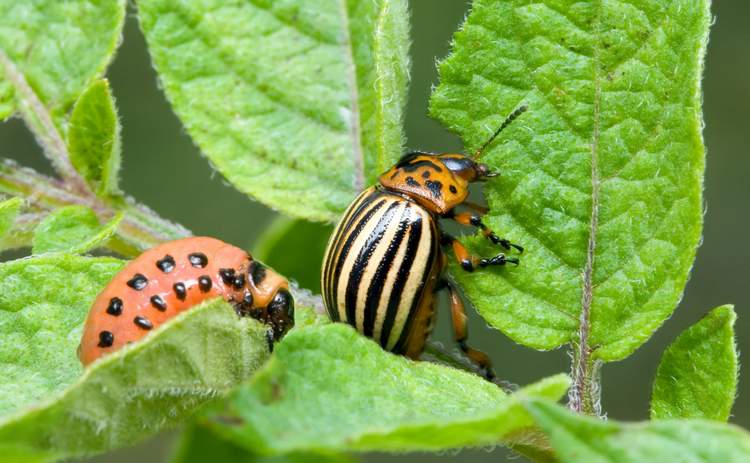
Wireworms
Larvae of all nutcracker beetles, 10-45 mm long. Larvae eat potato tubers, initially gnawing holes in them, can gnaw young shoots of grapes. Folk remedies: the introduction of chalk, ammonia fertilizers (saltpeter) into the soil, spreading crushed eggshells on the ground. Interesting! Before digging the site, it is advisable to add salt to the soil once every 7 years. Very effective tool! Soil “Protection” helps in the fight against pest.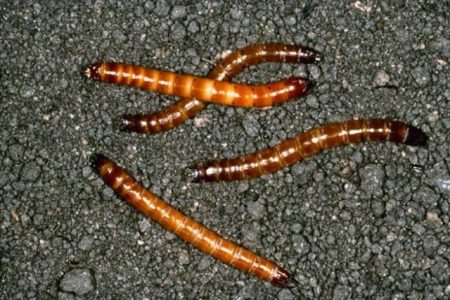
Cicadas
Insects resemble aphids or potato fleas. They damage potato leaves, infect them with spores of fungi and various dangerous infections. Chemical means of pest control: before planting potato tubers, they are treated with Tabu or Kruizer preparations. Interesting! At the first occurrence of an insect on a row of rows between rows, you should irrigate Karate Zeon.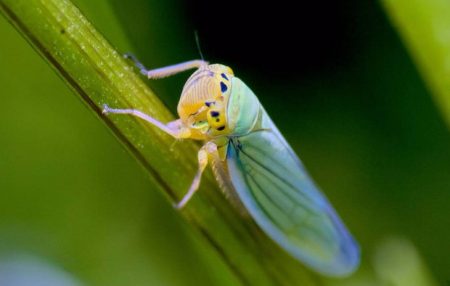
Medvedka
It reaches a size of 5-8 cm. It flies at an altitude of up to 5 m. A very voracious predator that eats the entire underground part of the potato. Methods of control: before planting, tubers are soaked in modern insecticides (toxic substances). During the growing season of potatoes, the soil is irrigated with special organophosphorus compounds.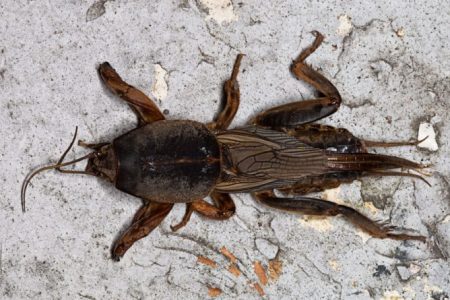
Mouse rodents
Representatives of this type of pests are field mice, rats, hamsters, etc. The method of control is deratization using all known substances.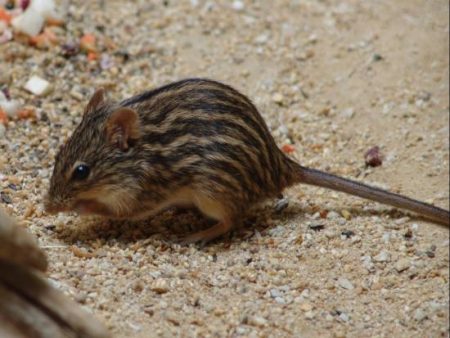
Chafer
Insect up to 31.5 mm long, body red or red-black. Beetle larvae from the second year of life eat root crops. Chemical means of insect killing: bazudin, antichrush, earthlings, repair. Folk remedies: deeply dig the earth, then add a washing solution called “White” or bleach; collect larvae by hand; in spring, pour diluted ammonia (at the rate of 10-20 ml per bucket of water) beds of strawberries and other plants; cultivate the land and foliage of shrubs with infusion of onion husks (based on 100 g of dry weight per bucket of water, leave for 5 days); next to fruit trees and shrubs, plant a plant known as a white creeping clover, whose roots accumulate nitrogen, which repels insects.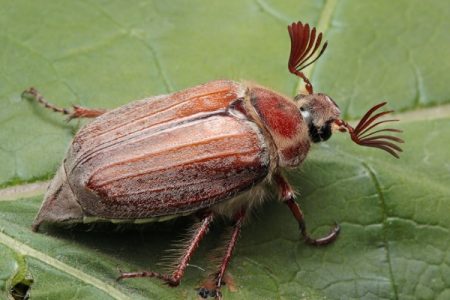
Naked slugs
Insects feed on tops and root crops.Means of control: ash with the addition of 25-30% lime at the rate of 200-250 kg / ha and superphosphate - 300-600 kg / ha, spraying of crops with a 10% aqueous solution of sodium chloride. It should be sprayed at night when the insect comes out to feed.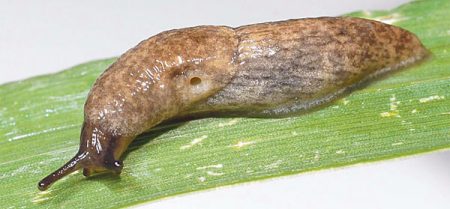
Potato flea
Attention!!! A small brown insect infects potato leaves, the larvae eat the root system of the plant. To destroy the pest, they use the Tabu insecticide, and they also treat the bushes with a 0.2% phosphamide solution (plants are treated every 10 days until the tubers are set).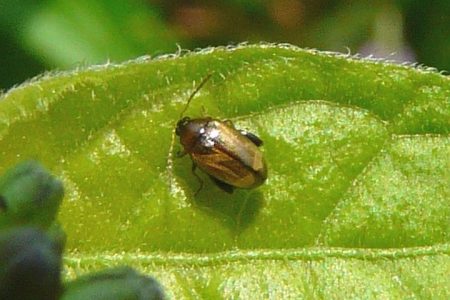
Potato nematodes
Microorganisms invisible to the naked eye. Their presence can be determined by the lag in the growth of bushes.
Interesting!!! Agrotechnical control: planting different varieties of potatoes in one area.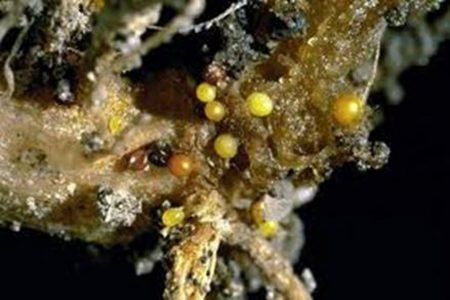
Potato scoop
Butterfly larvae (light caterpillar) feed on potato tubers, destroying the stem of the plant. The most effective ways to destroy the pest are to destroy weed grass and set traps with pheromones.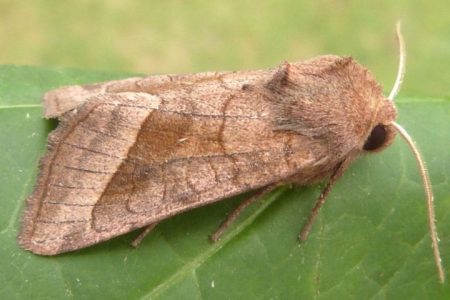
Potato moth
Larvae of the moth feed on tops and root crops. The butterfly is very prolific and can bring several generations of larvae. Mechanical means of destruction: storage of seed at a temperature of 5 degrees; planted tubers warm well; high hilling of potato bushes; deep seasonal digging of the earth.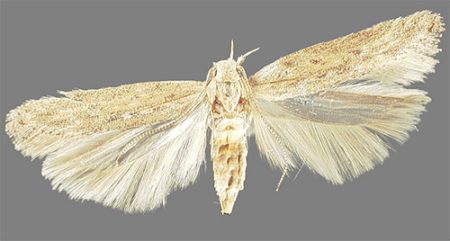
Potato large aphid
The insect spreads several tens of viral diseases. Mechanical means of control: harvesting weeds and thorough harvesting from the fields. Chemical method: treatment of plants with organophosphorus compounds, and treatment of tubers with pyrethroids, neonicotinoids.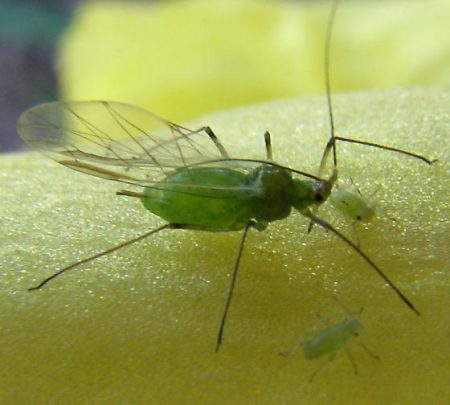
In addition to the aforementioned, well-known solanaceous eaters, it is also worth noting: certain types of ladybugs, spaniard fly (it is also a bobbin or dowel), potato 28-spotted cow, cruciferous fleas (gnawing leaf flesh) and bedbugs, caterpillars of gnawing scoops. In total, potatoes are affected: viruses - 23 species, bacteria - 6 species, aphids - 9, 68 species of worms, 38 different fungi and 119 other insects. So, shpanka last year attacked the fields in the Irkutsk region.
Prevention
To preserve the health of consumers of potatoes, increase their safety and yield, agronomists and homeowners are trying to pay maximum attention to preventive measures to combat solanaceous eaters and its diseases. At the same time, the rules of crop rotation, disinfection, and planting of various green fertilizers (green manure) are being improved. Bedbugs of the genus Podisus and certain species of ladybugs help get rid of various bugs. Onions and garlic, nasturtium, tansy, marigolds, coriander, thyme, horseradish, peppermint, and leaf mustard are planted near potato beds. With the sudden onset of a disease or attack by a pest, various folk remedies or various biological protection methods are used. Specialists use toxic substances only in extreme cases, if other methods of control have not brought the desired result. Which method of prevention gardeners choose depends on their capabilities and experience.
Reviews
Most of the feedback from the owners of potato plantations boils down to the fact that pests gradually develop relative immunity to constantly used chemicals. It is advisable to periodically replace them. Actively use folk remedies and new chemicals in the disinfection of planting material.The direct opponents of pests, in addition to the owners of the crops themselves, can be birds that eat up many of the insects and worms listed above, helping to get rid of them, at least partially, thereby saving the crop. It is necessary to arrange feeders for birds in the winter, and to install drinking bowls in the summer.




 Description and description of varieties in Belarus with a photo
Description and description of varieties in Belarus with a photo Do I need to pick flowers from potatoes: why do they do it
Do I need to pick flowers from potatoes: why do they do it When to dig potatoes: timing and availability of new potatoes
When to dig potatoes: timing and availability of new potatoes How to grow a good potato crop: various methods and methods, planting and care
How to grow a good potato crop: various methods and methods, planting and care